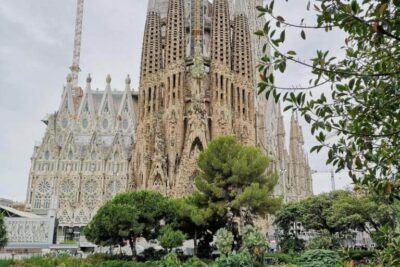
- The Architectural Marvel of La Sagrada Familia: A Closer Look
- Exploring the Symbolism Behind La Sagrada Familia's Design
- The Impact of Antoni Gaudí on La Sagrada Familia's Construction
- Visiting La Sagrada Familia: Tips for an Unforgettable Experience
- The Role of Nature in La Sagrada Familia's Artistic Expression
- Understanding the Cultural Significance of La Sagrada Familia in Barcelona
La Sagrada Familia, an iconic basilica designed by the visionary architect Antoni Gaudí, stands as a testament to architectural innovation and spiritual devotion. Its intricate facades and soaring towers attract millions of visitors each year, showcasing a blend of Gothic and Art Nouveau styles that is truly unique.
Amidst the vibrant streets of Barcelona, the basilica's grandeur captivates all who behold it. This architectural masterpiece is not just a structure; it embodies **The Majestic Beauty of La Sagrada Familia in Barcelona, Spain**, reflecting Gaudí's deep reverence for nature and religion, making it an unforgettable landmark of cultural significance.
The Architectural Marvel of La Sagrada Familia: A Closer Look
The architectural marvel of La Sagrada Familia lies not only in its grand design but also in the meticulous attention to detail that defines every aspect of its construction. Gaudí's innovative use of geometry and natural forms creates a sense of harmony that resonates throughout the basilica. The interplay of light within the interior, achieved through strategically placed stained glass windows, enhances the spiritual atmosphere and connects visitors with the divine.
One of the most striking features of La Sagrada Familia is its tower design, which symbolizes various aspects of Christianity. The basilica is intended to have a total of 18 towers, each representing different figures in the Christian faith, including:
- 12 Apostles
- 4 Evangelists
- 1 Virgin Mary
- 1 Jesus Christ
Beyond its external beauty, the structural innovations employed in La Sagrada Familia are equally impressive. Gaudí utilized a method known as hyperbolic paraboloids and other complex forms to ensure stability while achieving an ethereal appearance. This technique allows the basilica to withstand natural forces, showcasing Gaudí's forward-thinking approach to architecture.
As construction continues, La Sagrada Familia remains a testament to the enduring nature of human creativity and faith. Each year, thousands of artisans, architects, and engineers contribute to its completion, making it a living project that evolves with time. The blend of traditional craftsmanship and modern technology stands as a symbol of Barcelona's commitment to preserving its cultural heritage while embracing the future.
Exploring the Symbolism Behind La Sagrada Familia's Design
The design of La Sagrada Familia is imbued with profound symbolism, reflecting Gaudí's spiritual beliefs and his desire to convey messages through architecture. Every element of the basilica, from its intricate facades to its towering spires, serves a purpose beyond mere aesthetics. For instance, the use of natural forms in the structure is a homage to God’s creations, emphasizing the interconnectedness of nature and spirituality.
Each facade of La Sagrada Familia carries its own narrative, illustrating pivotal moments in the life of Jesus Christ. The Nativity Facade portrays the birth of Jesus with scenes that celebrate life and nature, while the Passion Facade reflects the suffering and sacrifice of Christ, depicted through stark and angular forms. This duality in design invites visitors to engage emotionally with the sacred story represented in stone.
Moreover, the basilica's light symbolism is masterfully executed through the use of stained glass. The vibrant colors of the glass change throughout the day, creating a dynamic interplay of light that symbolizes the divine presence. This design choice not only enhances the spiritual ambiance but also serves to remind visitors of the ever-changing nature of faith and spirituality.
Gaudí’s intent for La Sagrada Familia goes beyond its completion; it is a reflection of human aspiration and devotion. Each of the 18 towers represents a significant figure in Christianity, forming a vertical expression of faith reaching towards the heavens. This architectural marvel stands as a reminder of the ongoing journey of creation and the deep-seated hope that inspires it.
The Impact of Antoni Gaudí on La Sagrada Familia's Construction
Antoni Gaudí's profound impact on the construction of La Sagrada Familia is evident through his innovative approach to architecture. His vision transformed the basilica into a unique blend of art and spirituality, resulting in a structure that reflects his deep reverence for both nature and faith. Gaudí meticulously crafted every detail, ensuring that the basilica not only serves religious purposes but also inspires awe in its visitors.
One of the key aspects of Gaudí's influence can be observed in his use of natural forms and geometrical shapes. He integrated elements that mimic nature, which can be seen in:
- The tree-like columns inside the basilica
- The organic shapes of the facades
- The innovative use of light through stained glass
Moreover, Gaudí's incorporation of structural innovations set La Sagrada Familia apart from traditional buildings. His pioneering techniques, such as the use of hyperbolic paraboloids, not only enhanced the aesthetic appeal but also ensured the stability of the structure. This forward-thinking approach highlights Gaudí's commitment to creating a lasting architectural masterpiece.
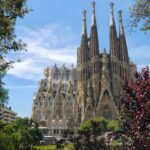 The Majestic Beauty of Sagrada Familia in Barcelona, Spain
The Majestic Beauty of Sagrada Familia in Barcelona, SpainAs construction progresses, Gaudí's legacy continues to shape the ongoing work at La Sagrada Familia. Today, his original plans and sketches guide a new generation of architects and artisans who strive to complete the vision he laid out over a century ago. This collaborative effort exemplifies the timeless impact of Gaudí's genius on Barcelona and the world of architecture.
Visiting La Sagrada Familia: Tips for an Unforgettable Experience
Visiting La Sagrada Familia can be an extraordinary experience, but to make the most of your time, **planning ahead** is essential. Consider booking your tickets online to avoid long queues, especially during peak tourist seasons. This not only saves you time but also ensures that you secure your preferred time slot. Arriving early in the morning or later in the afternoon can also provide a more serene atmosphere, allowing you to appreciate the basilica's beauty without the crowds.
When exploring the interior, take a moment to observe the magnificent stained glass windows. The vibrant colors shift throughout the day, creating a breathtaking interplay of light. To enhance your visit, consider joining a guided tour. Knowledgeable guides can share insights into Gaudí's vision and the intricate details of the architecture, enriching your understanding of this masterpiece. Additionally, audio guides are available, offering a more personal exploration of the basilica's history and significance.
For a complete experience, **explore the surrounding area**. The streets around La Sagrada Familia are filled with charming cafes and shops where you can enjoy local cuisine. After your visit, unwind at nearby parks, such as the Parc de la Ciutadella, which offers a peaceful setting to reflect on your experience. Don't forget to take plenty of photos, but remember to also take time to simply absorb the stunning views of this iconic structure.
Lastly, be mindful of the **dress code** when visiting La Sagrada Familia, as it is a place of worship. Modest attire is appreciated to maintain the sanctity of the space. By keeping these tips in mind, your visit to La Sagrada Familia will surely be an unforgettable chapter in your journey through Barcelona.
The Role of Nature in La Sagrada Familia's Artistic Expression
The role of nature in La Sagrada Familia's artistic expression is evident in Gaudí's profound understanding of natural forms. He believed that architecture should emulate the beauty and complexity of nature, leading him to incorporate organic shapes and structures reminiscent of trees and plants. For instance, the basilica's columns are designed to resemble tree trunks, branching out to support the vaulted ceilings, creating a sense of being enveloped by a forest. This innovative approach not only reinforces the building’s stability but also infuses the space with a tranquil, natural ambiance.
Additionally, Gaudí's use of light plays a crucial role in enhancing the connection to nature. The stained glass windows are crafted to reflect the colors of the natural world, transitioning through the spectrum as sunlight filters through them. This creates a dynamic atmosphere within the basilica, where the interplay of light and shadow evokes the changing conditions of the environment outside. Such design choices symbolize the divine, reminding visitors of the beauty of creation and the spiritual harmony found in nature.
Moreover, the facades of La Sagrada Familia showcase intricate carvings and motifs inspired by flora and fauna, further emphasizing Gaudí's dedication to nature. Each element serves a dual purpose: contributing to the overall aesthetic while also conveying deeper meanings related to the cycle of life. The Nativity Facade, for instance, is adorned with scenes of wildlife and plant life, celebrating the birth of Jesus in a way that highlights the interconnectedness of all living things. This artistic expression invites reflection on humanity's relationship with the natural world.
In summary, the integration of natural elements in La Sagrada Familia not only enhances its artistic beauty but also serves as a testament to Gaudí's vision of a sacred space that reflects the divine presence in the world around us. By drawing inspiration from nature, he created a sanctuary that transcends traditional architectural boundaries, inviting visitors to experience a profound connection to both spirituality and the environment.
Understanding the Cultural Significance of La Sagrada Familia in Barcelona
La Sagrada Familia is not only an architectural masterpiece but also a profound reflection of Barcelona's cultural identity. It serves as a symbol of the city’s rich history, uniting both local and global communities in appreciation of Gaudí's vision. The basilica's construction has become a cultural phenomenon, drawing millions of visitors who contribute to the ongoing dialogue about art, faith, and humanity.
Understanding the cultural significance of La Sagrada Familia involves recognizing its role as a beacon for artistic innovation. The collaboration of numerous artisans and architects over the years has fostered a sense of shared purpose and creativity. This collective effort underscores the importance of community in preserving cultural heritage, as evidenced by:
- The integration of traditional craftsmanship with modern techniques
- Local involvement in the construction process
- The basilica’s evolving status as a UNESCO World Heritage Site
Furthermore, La Sagrada Familia's design is deeply intertwined with the spiritual beliefs of its creator, Antoni Gaudí. His intention was to create a space where architecture and spirituality converge, inviting people from diverse backgrounds to connect with the divine. This aspiration is reflected in the basilica's intricate details, which convey messages of faith and devotion, making it a significant pilgrimage site for many.
In addition to its religious importance, La Sagrada Familia serves as a cultural touchstone for contemporary discussions on sustainability and environmental awareness. Gaudí's emphasis on natural forms and light not only enhances the aesthetic experience but also promotes a deeper understanding of our connection to the environment. This relevance to modern issues highlights the basilica's timeless influence and its ongoing role in shaping Barcelona's cultural landscape.
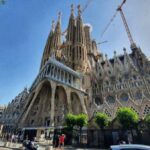 The Fascinating History of Sagrada Familia Barcelona: A Peek into its Past
The Fascinating History of Sagrada Familia Barcelona: A Peek into its PastIf you want to know other articles similar to The Majestic Beauty of La Sagrada Familia in Barcelona, Spain you can visit the category Sagrada Familia.
Deja una respuesta

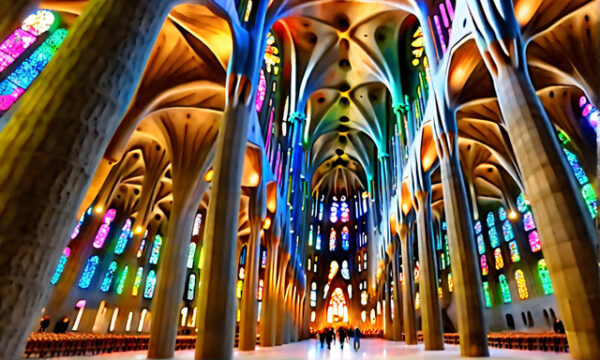
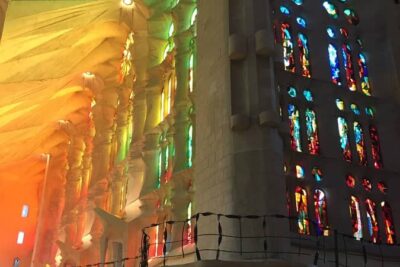



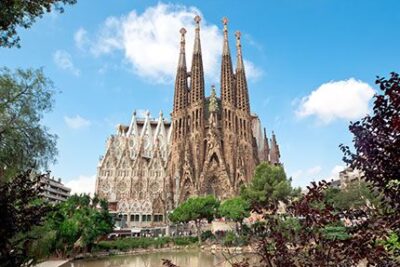
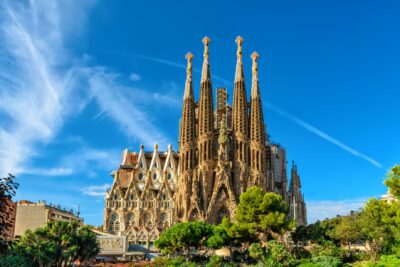
Read more!